Highlight
- Incidence of intrahepatic cholangiocarcinoma (iCCA) rose markedly in Sweden from 2011 to 2021, especially among low-income individuals and men.
- Lower-income patients exhibited higher rates of late-stage iCCA and a greater prevalence of preventable liver diseases compared to higher-income counterparts.
- Disparities persisted in treatment access, with low-income patients less likely to receive systemic therapy and facing higher mortality even after treatment.
- These socioeconomic disparities remain despite Sweden’s universal healthcare system, highlighting unmet needs in equitable cancer care.
Study Background and Disease Burden
Intrahepatic cholangiocarcinoma (iCCA) is a primary liver cancer arising from the bile ducts within the liver. Globally, its incidence is increasing, with prognosis generally poor due to late-stage diagnosis and limited effective systemic therapies. Understanding the socio-demographic factors influencing disease burden and treatment access is vital to improving outcomes.
In countries with universal healthcare, such as Sweden, equal access to medical care is an established principle. However, whether socioeconomic status (SES) influences cancer incidence, treatment choices, and survival outcomes remains incompletely understood. This is particularly relevant for iCCA, whose risk factors include preventable liver diseases that may cluster unequally across SES strata.
This nationwide cohort study conducted by Vaz et al., published in Lancet Regional Health Europe in 2025, investigates SES-related disparities in iCCA incidence, treatment, and survival within Sweden’s universal healthcare setting, providing important insights into persistent health inequalities.
Study Design
This observational cohort study utilized national Swedish registries to identify all adult patients diagnosed with iCCA from 2011 through 2021 (n=1827). Key sources included the Swedish quality register for liver cancer, linked with socioeconomic and healthcare datasets.
Household income served as the SES indicator, categorized into low (lowest quartile nationally), medium, and high (highest quartile). Outcomes studied included age-standardized incidence rates (IRs), treatment patterns (notably systemic therapy), and survival based on income category.
Analyses adjusted for potential confounders such as age, sex, and comorbid conditions. Incidence rate ratios (IRRs), odds ratios (ORs) for treatment receipt, and hazard ratios (HRs) for mortality were calculated with accompanying 95% confidence intervals (CIs).
Key Findings
The study revealed increasing iCCA incidence rates in Sweden over the decade, from 1.35 to 1.94 per 100,000 person-years. The most pronounced increase occurred among men and individuals within the low-income group.
Compared with high-income individuals, those categorized as low income had significantly higher IRRs for iCCA overall (1.32; 95% CI: 1.15-1.52) and for late-stage disease presentation (1.46; 95% CI: 1.17-1.81). This suggests both greater exposure to risk factors and later diagnosis timing among lower SES groups.
Epidemiological characterization of comorbidities indicated that preventable liver diseases (e.g., alcoholic liver disease, hepatitis infections) were more prevalent in low-income patients. Conversely, higher-income patients more frequently presented with primary sclerosing cholangitis and inflammatory bowel disease—conditions traditionally associated with iCCA risk but less linked to socioeconomic deprivation.
Regarding treatment, low-income patients had significantly lower adjusted odds of receiving systemic therapy (OR 0.54; 95% CI: 0.38-0.77). Among those treated, low income was also associated with higher adjusted mortality risk (HR 1.34; 95% CI: 1.09-1.65), indicating disparities not only in access but also in survival outcomes.
Despite Sweden’s universal healthcare, these data illustrate persistent socioeconomic inequities affecting all major aspects of iCCA care—from incidence and stage at diagnosis to treatment receipt and survival.
Expert Commentary
The study by Vaz et al. provides rigorous, population-level evidence that health disparities persist in advanced liver cancer, even under equitable healthcare systems. Several factors may contribute: greater prevalence of modifiable risk factors (e.g., alcohol use, viral hepatitis) among lower SES groups; potential differences in health-seeking behavior and diagnostic timing; and subtle inequities in access to specialized oncological interventions.
These findings align with international evidence linking socioeconomic deprivation to poorer cancer outcomes, emphasizing that availability of healthcare coverage alone does not eliminate disparities. Incorporating comprehensive public health strategies to prevent liver disease, improving early detection among vulnerable populations, and addressing barriers to systemic therapy are critical next steps.
Limitations include observational design precluding causal inference, lack of granular data on lifestyle factors, and potential residual confounding. Nonetheless, the study represents a valuable benchmark for policymakers and clinicians aiming to reduce health inequities in liver cancer care.
Conclusion
This nationwide Swedish cohort study highlights stark socioeconomic disparities in the incidence, stage at diagnosis, treatment utilization, and survival of intrahepatic cholangiocarcinoma. Despite universal healthcare access, low-income individuals face a disproportionate burden of iCCA and worse outcomes.
Efforts to mitigate these disparities will require multifaceted approaches, including targeted liver disease prevention, enhanced early diagnosis, and equitable cancer care delivery. Continual monitoring of socioeconomic inequalities in cancer care is essential to inform effective health policy and improve outcomes for all patients irrespective of income.
References
1. Vaz J, Hagström H, Sandström P, Eilard MS, Rizell M, Strömberg U. Socioeconomic disparities in incidence, treatment, and survival of intrahepatic cholangiocarcinoma: insights from a nationwide cohort study in Sweden. Lancet Reg Health Eur. 2025 Aug 5;57:101415. doi:10.1016/j.lanepe.2025.101415. PMID: 40809904; PMCID: PMC12346144.
2. Khan SA, Roberts LR. Cholangiocarcinoma. Lancet. 2020;396(10269):1959-1973.
3. Petrick JL, Kelly SP, Altekruse SF, et al. Future of liver cancer incidence in the United States: Projections through 2030. Hepatology. 2020;72(6):1918-1928.
4. Marmot M. The Health Gap: The Challenge of an Unequal World. Lancet. 2020; 395(10221): 1870-1872.
5. Kim R, Jang J, Kaushik A, El-Serag HB. Impact of Socioeconomic Disparities on Liver Cancer Outcomes in the United States: A Systematic Review. Clin Gastroenterol Hepatol. 2022;20(9):1874-1887.


